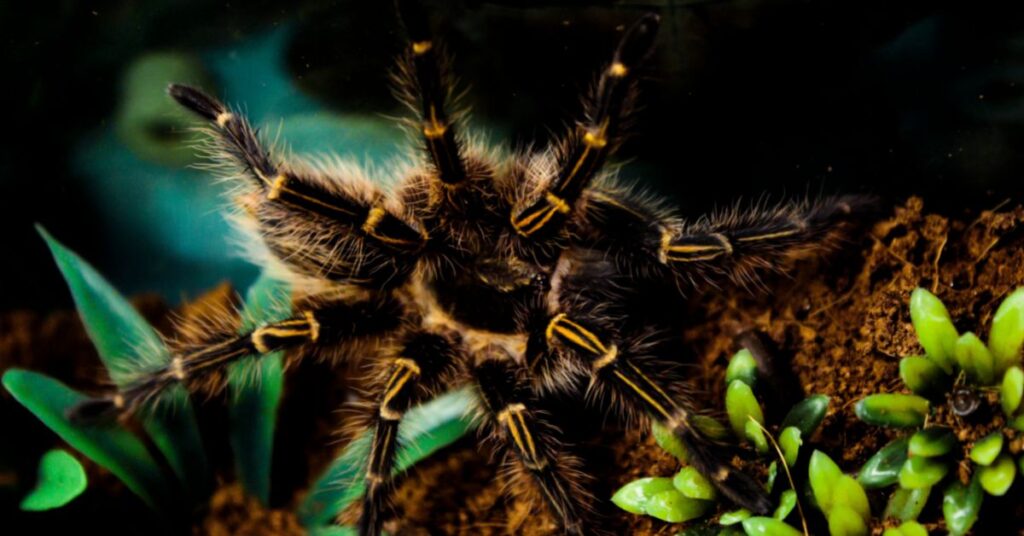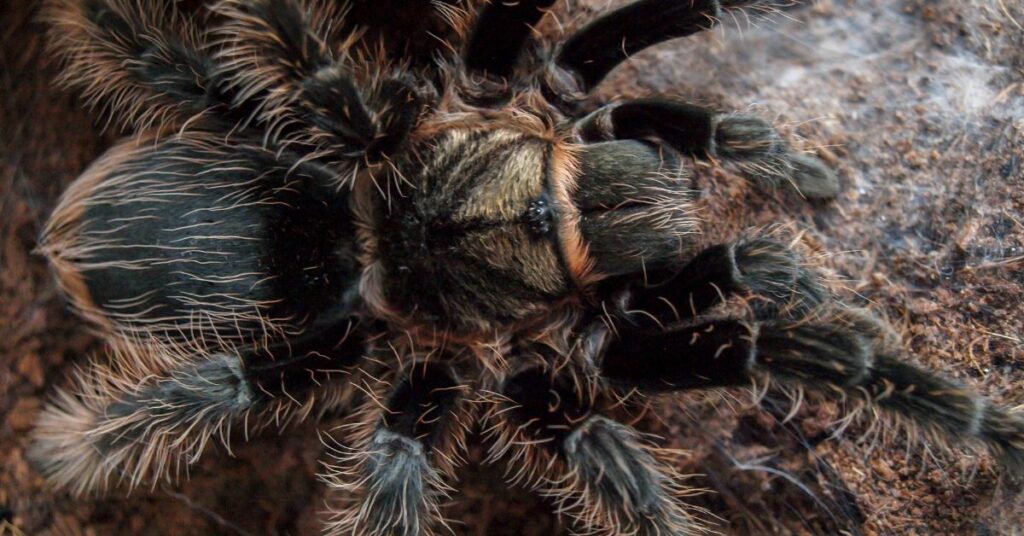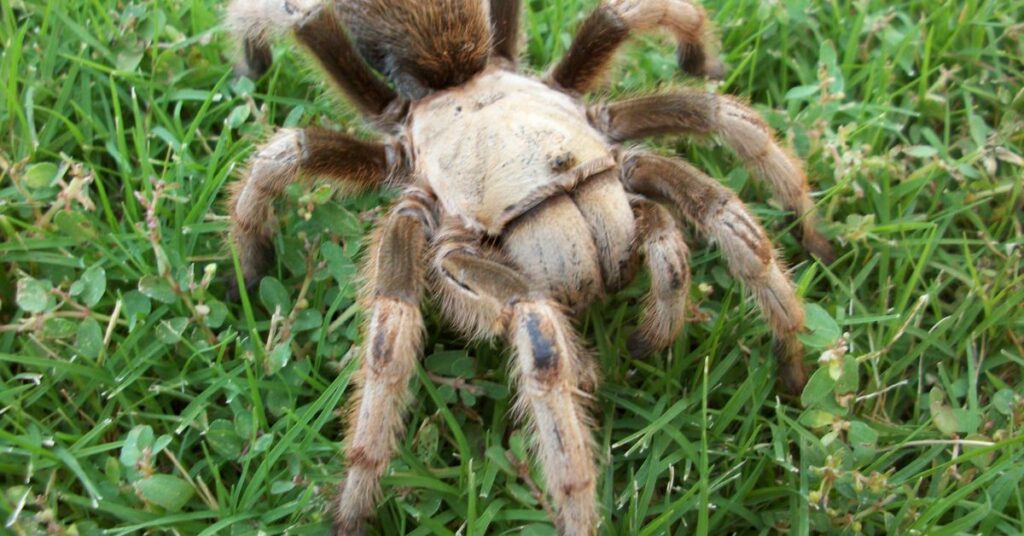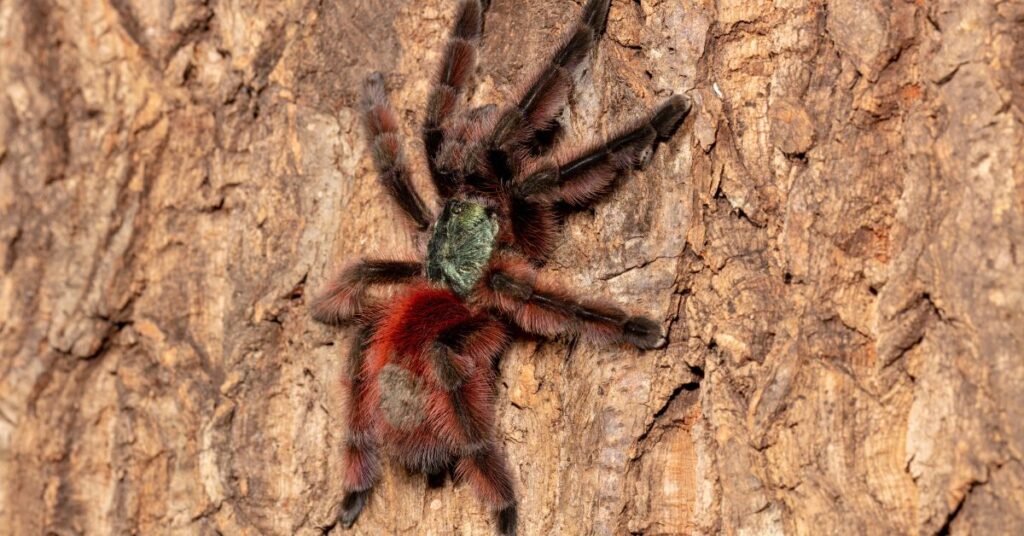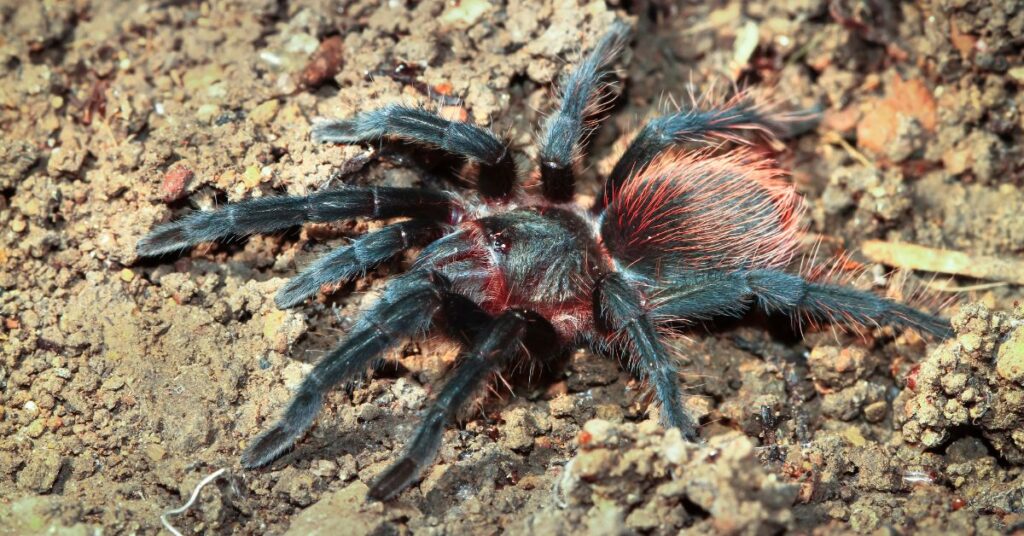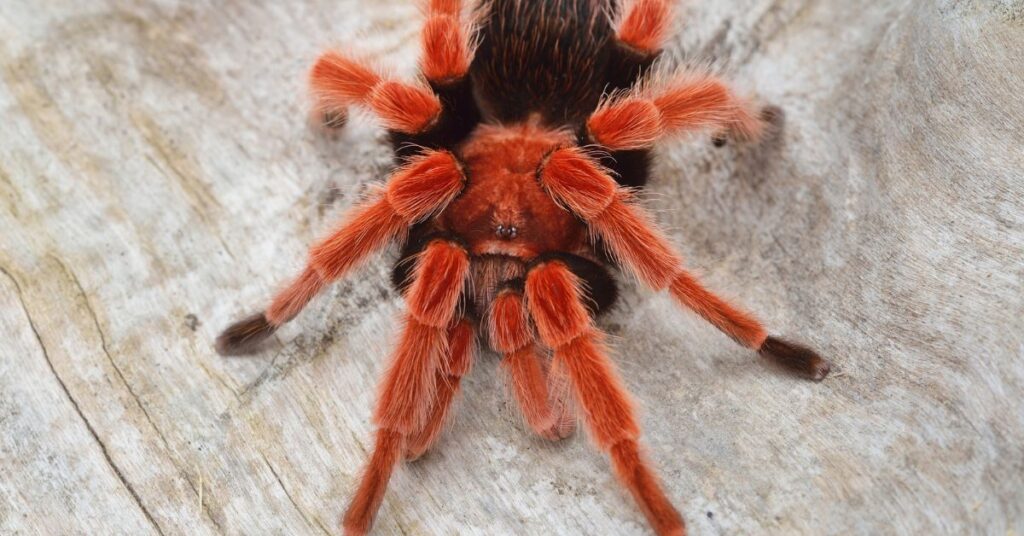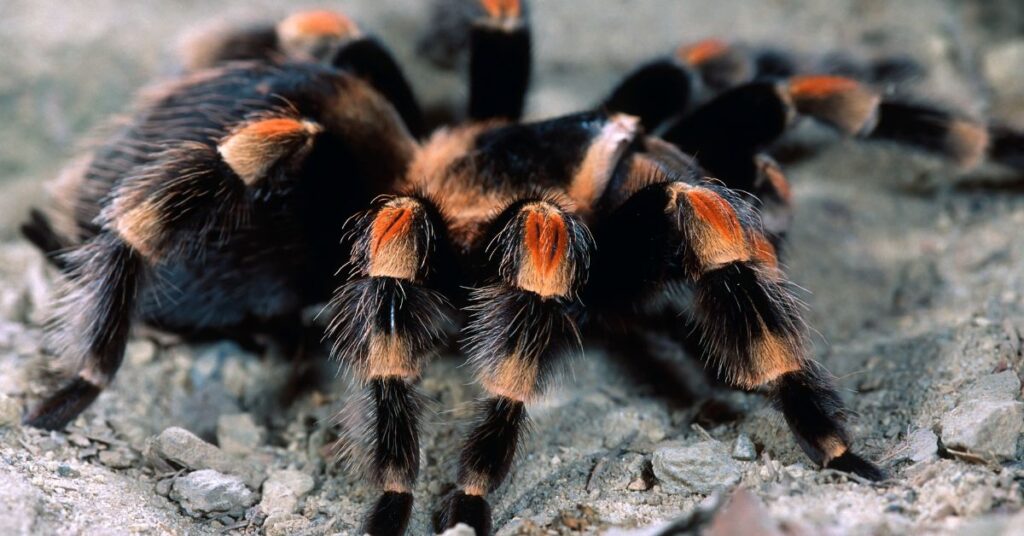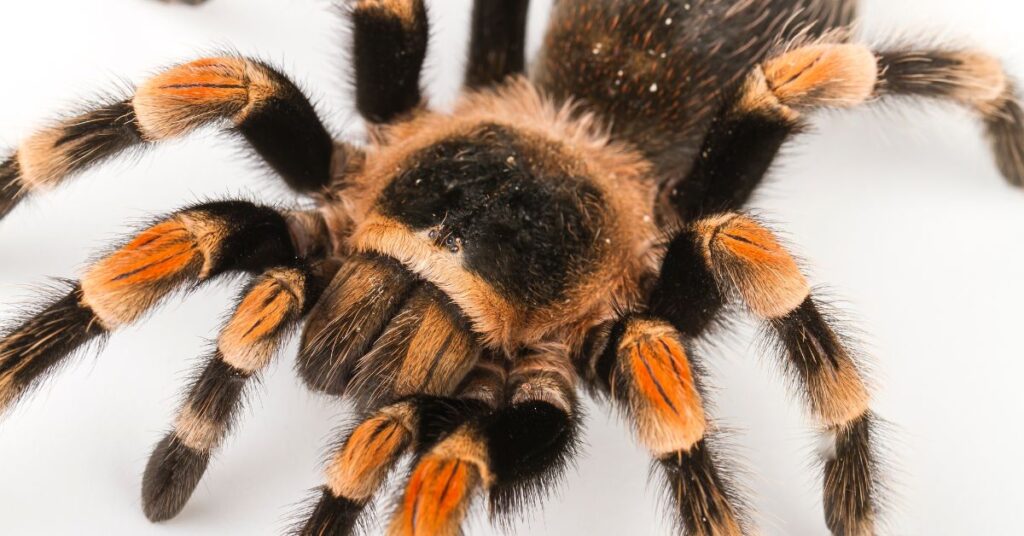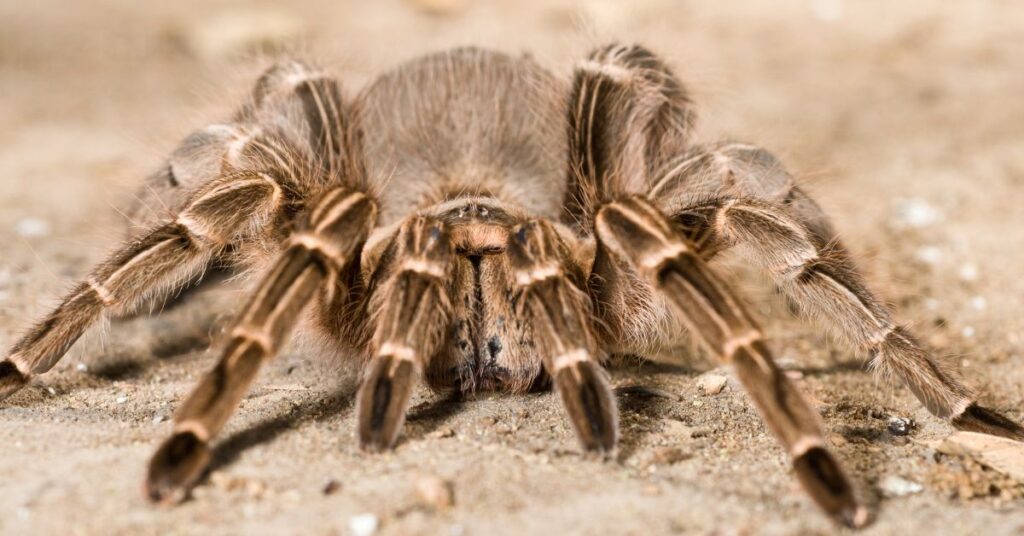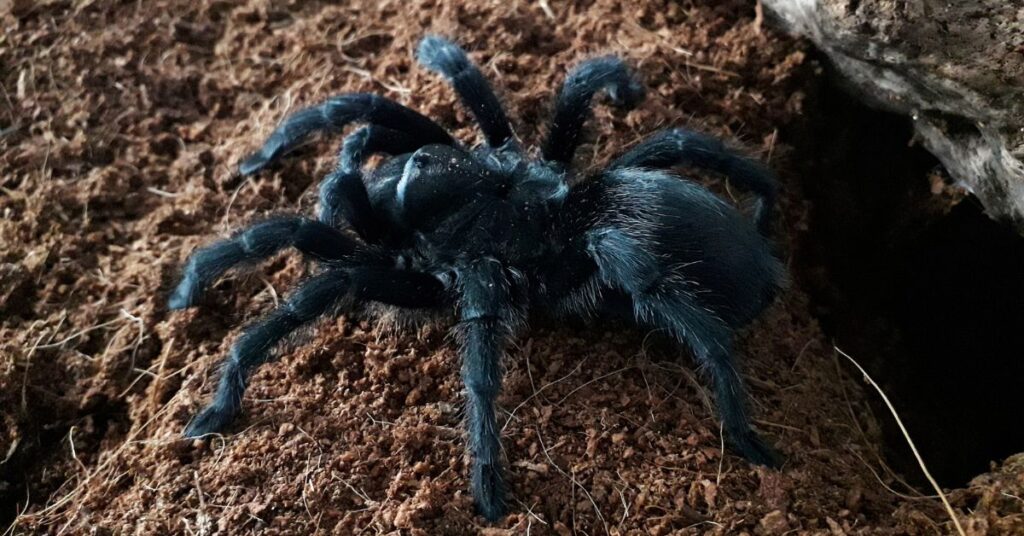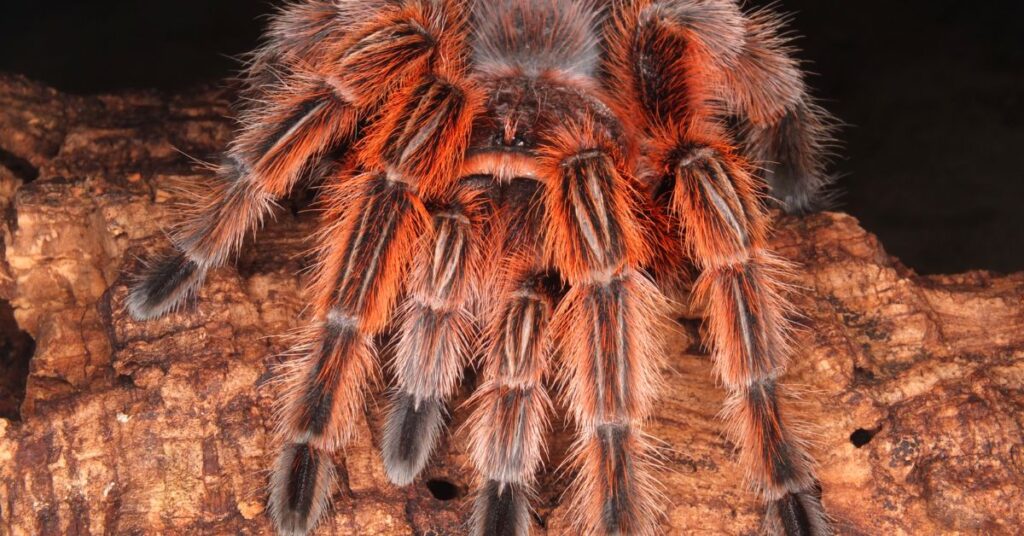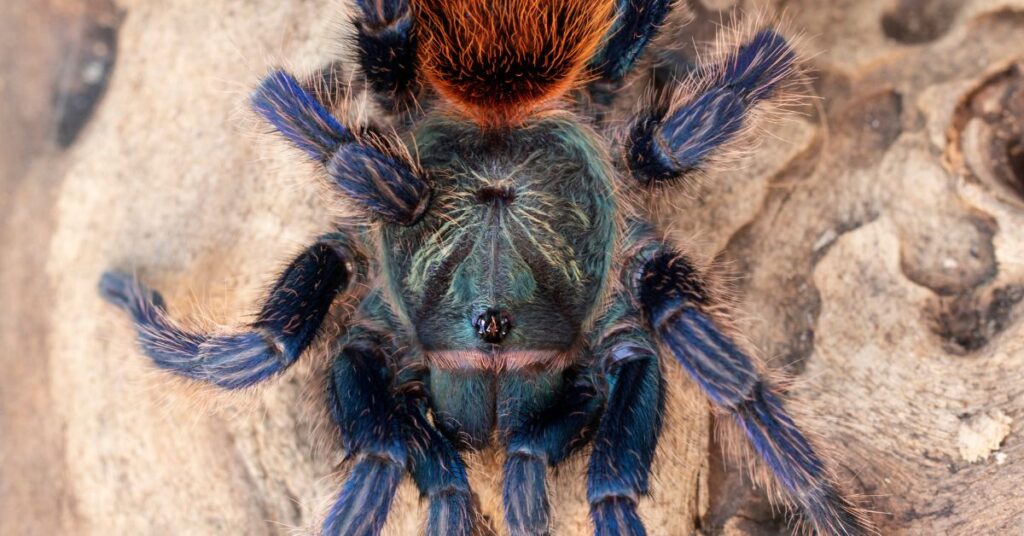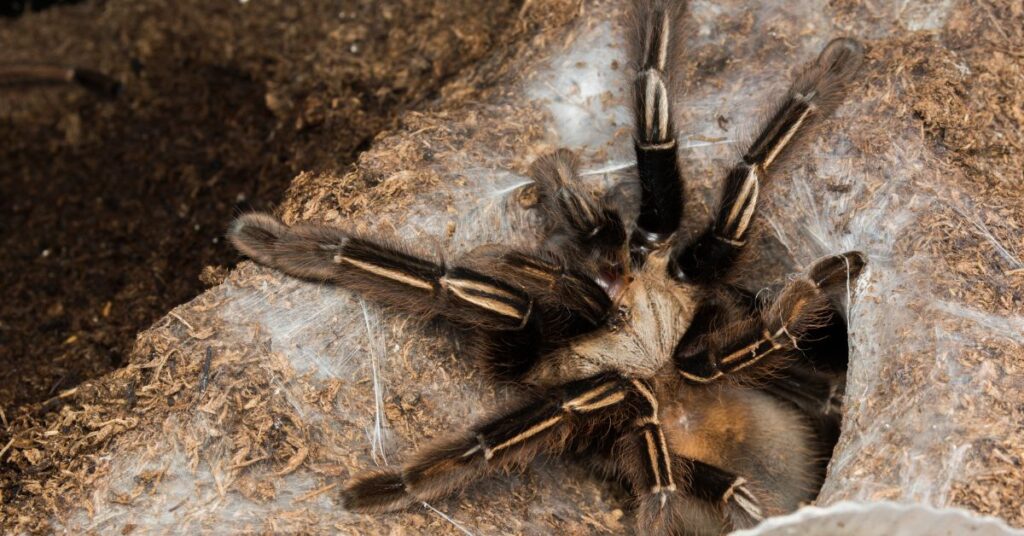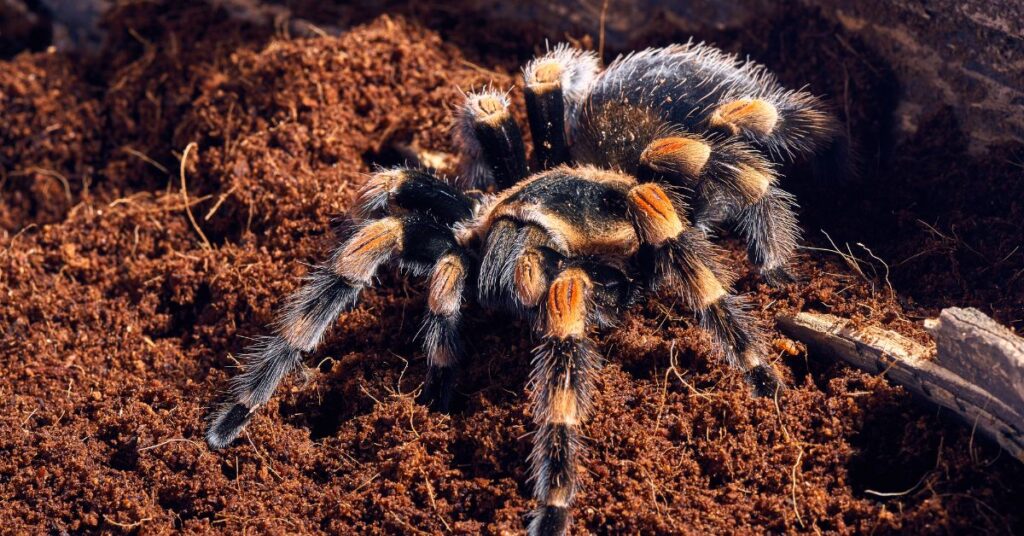
Tarantulas are the perfect pet to keep if you don’t have a lot of space but don’t want the smell/mess that comes with small mammals (think gerbils, hamsters, etc) or you simply don’t have the time to be routinely cleaning cages 24/7.
For example, if you want to keep some rare birds, you need a large cage and an open space before you even begin to think about environment, food, accessories etc.
To keep a tarantula, you just need a medium-sized container, with some small, drilled holes in for air circulation, put in some coco-fibre substrate and a cork bark hide. That’s it. Of course as your collection grows, so will your housing etc.
For further details, check out our list of pros and cons of owning a tarantula then come back and continue reading our list of 15 best tarantulas for beginners (in our opinion!).
Chaco Golden Knee (Grammostola pulchripes)
One of the larger species of tarantula, the Chaco golden knee (formerly known as Grammostola aureostriata), can be expected to reach around 8.5”.
The Chaco golden knee tarantula is known to inhabit the grasslands of Argentina and Paraguay. It has long light-colored hairs all over its body and gold stripes on its legs, particularly at the “knees”. This is a good display species as it often sits in plain view.
It is a very calm and docile tarantula, which, along with its striking appearance and large size, makes it an attractive pet, especially for beginners.
The Chaco golden knee is an opportunistic burrowing terrestrial tarantula: they tend to burrow while younger and adopt a pre-existing hide as its home when it begins to mature.
Females can live for well over twenty years, while males only live for about five or six years.
Curly Hair Tarantula (Tliltocatl albopilosus)
Curly Hair Tarantulas are largely terrestrial, opportunistically burrowing spiders and are named for their long, slightly curled hairs that cover their legs and some of their body.
These bristles are often dark brown or black, but they can also have a golden sheen.
This species is great for first-time owners. They are docile, hardy, low maintenance, and very calm. They also enjoy sitting in your hand or on your arm.
Curly Hair Tarantulas tend to sit in one spot most of the time. However, they can be seen hunting and occasionally rearranging their tank.
They are generally better suited to pet owners who want a quiet spider and females have been reported to live up to 20 years.
Arizona Blonde Tarantula (Aphonopelma chalcodes)
The Arizona Blonde Tarantula is also known as the Desert Blonde. They are found in the southwestern United States, mostly in Arizona. Because they are a US species, they are often easier to find and cheaper than most pet tarantulas.
This spider is normally brown or black and easily blends in with its desert environment.
They are considered generally extremely docile, are able to be held and are comfortable with slight handling although they will never be tame or cuddly little pets.
If they do decide to bite, their venom is on a par with a bee sting making them one of the less venomous tarantulas out there.
Males will live 5-10 years, while females can live up to 30 years old. They are very hardy spiders that are well-suited to beginners.
Want to know more about the Arizona Blonde? Read our article dedicated to these babies here.
Antilles Pinktoe Tarantula (Caribena versicolor)
These tropical spiders are native to Martinique but are commonly bred in captivity. These tarantulas are tree-dwellers so as pets, their tank should be taller than it is wide. They also live best with branches or cork to climb.
This spider is usually black or brown with brightly coloured leg tips. The leg tips can vary from orange to pink, and the darker body colours can have a blue-green sheen. They are medium in size with a 5” body span and their beautiful colour makes them one of the best pet species to look at.
Spiderlings of C. versicolor are bright blue, with a black tree trunk pattern on the abdomen. As they grow, they gradually lose their blue coloration; males usually are slightly more brightly coloured than females.
Pink Toes are very docile, simple to care for and will happily crawl across your hand although they are very similar to the jumping spider in that they will jump if they feel threatened.
Unfortunately, they don’t live as long as some of the other spiders on our list, with females living up to 12 years.
Mexican Redrump Tarantula (Tliltocatl vagans)
The Redrump species ranges prominently from Mexico but is also found in Central America. The Mexican Redrump Tarantula is one of several Mexican red species.
The reason for the name “red rump” is because of its distinctive red hairs on its abdomen. The rest of their body is usually a black or dark brown colour.
Redrumps live in areas of low, dry vegetation, which allows them to easily dig tunnels. They are a burrowing tarantula and have been shown to make extensive tunnel systems in the wild. As a pet they will need several inches of substrate to burrow.
The Mexican Redrump is a low maintenance, hardy tarantula and adapts very well to captivity. They may even tolerate gentle handling from time to time, but most of the time they will be out in the open in their 5-gallon tank.
They are typically docile, though they can be skittish and prone to releasing urticating hairs. Females are long-lived, potentially reaching 15 years of age.
Mexican Redleg Tarantula (Brachypelma emilia)
This tarantula has several mentions on our site as it has very basic care requirements and is low maintenance.
Obviously, as its name suggests, The Mexican Redleg Tarantula is another Mexican species. This spider is named after its red-orange legs. This orange colour covers the entire leg, unlike in the Mexican Redknee in which only parts of each leg segment are red.
They may not be as popular as the Mexican Redknee, (the next tarantula in our list) but they are docile pet tarantulas that rarely bite.
As mentioned in other articles on Spider Advisor, this species often tolerates being gently held from time to time.
Redlegs are often quiet and low maintenance. They generally will sit in one spot most of the time, but you may find them hunting for food, or trying to burrow into their substrate. They are a great pet for someone who only wants to watch and only occasionally feed their spider.
Female Red-Legged Tarantulas can live up to 30 years.
Mexican Redknee Tarantula (Brachypelma smithi)
The Mexican Redknee Tarantula is the most popular Mexican species. They tend to be more well-known and are easier to find at pet stores than the other Mexican species.
These tarantulas are known for their bright orange-red colouring. This orange-red color is most prominent on the “knees” of this species. The rest of this spider is often a brown colour.
The Mexican Red-knee tarantula is a popular beginner tarantula due to its long lifespan and easy care. Enthusiasts and keepers also adore these spiders due to their unique look.
Females live up to 25 years and males live for five to ten years.
We have an article dedicated to the Mexican red knee here.
Mexican Orange Beauty (Brachypelma baumgarteni)
The Mexican Orange Beauty is our third Brachypelma genus to make this list.
As with the Redknee and the Redleg, the Mexican Orange Beauty is a Mexican species. It is distinguishable from the others as it has more orange on its legs than the Redknee.
Again, the Mexican Red-knee tarantula is a popular beginner tarantula due to its long lifespan and easy care. Enthusiasts and keepers also adore these spiders due to their unique look.
Females live 20-40 years.
Chilean Gold Burst (E. parvulus formerly “Paraphysa parvula”)
This seemingly over-looked tarantula originates from Chile. They tend to be classed as “pet rocks” as they are quite sedentary little creatures.
It has a red patch on its abdomen and a dark metallic green carapace although you need to be looking at it in the right light or else it appears a simple brown colour.
It has a slow growth rate, and females can reach 4-4.5” in length.
The Gold Burst is a docile tarantula and makes a wonderful beginner tarantula. Please note however, that this little gem is quite difficult to come by, so it’s probably easier to go for one of the other, more available spiders.
Costa Rican Zebra Tarantula (Aphonopelma seemanni)
Also known as the striped-knee tarantula, the Costa Rican Zebra Tarantula is a species of tarantula inhabiting most of western Costa Rica and other parts of Central America, such as Honduras and Nicaragua. It is usually black with white stripes near the leg joints.
Zebra tarantulas are deep-burrowing spiders so plenty of substrate is required but they are highly adaptable, very hardy and easy to care for in captivity.
Costa Rican Zebras are one of the more calm and docile species. It is rare for it to throw its hairs and its venom is not dangerous to humans.
These spiders may live up to 15 years.
Brazilian Black Tarantula (Grammostola pulchra)
Brazilian Black Tarantulas are one of the best beginner spiders. They are famous for their docile temperament.
Grammostola pulchra is a species of tarantula (family Theraphosidae), native to Brazil. It is known for its solid black body, which makes it an appealing tarantula for hobbyists.
Their venom is also not as irritating as many other species of tarantulas although like most new world tarantulas it possesses urticating hairs.
However, if provoked, they would much rather flee than attack.
The Brazilian black is a slow grower, taking up to eight years to reach maturity, reaching up to 7 inches in length (measured diagonally).
This species of tarantula is known for being one of the calmest and most docile. They are not very quick and do not scare easily.
Again, females can live upwards of 20 years.
Chilean Rose Tarantula (Grammostola rosea)
Chilean Rose species are known for their varying colours, from a light tan to a rose-coloured brown. They are also known for being docile and submissive.
The Chilean Rose is probably the most common species of tarantula available in American and European pet stores today, due to the large number of wild-caught specimens exported cheaply from their native Chile into the pet trade.
They can be kept in relatively low humidity and are quite docile, which makes them very popular as pets.
Like most tarantulas, they can be fed infrequently and require little space.
Another thing that makes them attractive pets is that females can live considerably longer than 20 years.
Pumpkin Patch Tarantula (Hapalopus sp. Colombia)
The Pumpkin Patch Tarantula is considered to be a “dwarf” tarantula, meaning it is much smaller than the average species. It only grows up to three inches long and requires just a one-gallon tank (6”x6”x6”). This makes them ideal for pet owners who do not have much room to house their spider.
Pumpkin Patch Tarantulas are generally a solid orange-brown colour, and its body is black with orange patches, giving it a pumpkin-patch pattern.
They may be small, but this species can live a long life. Females live between 8 and 10 years and males 3 to 4 years.
The Pumpkin Patch is easy to care for and great for those who want a smaller spider.
Green Bottle Blue Tarantula (Chromatopelma cyaneopubescens)
The Green Bottle Blue Tarantula is well-known for its green, blue, and orange body and royal blue legs.
They are very active and fast-growing tarantulas that are particularly attractive to hobbyists.
Green Bottle Blues are not the most docile pet spider, but it is not overly defensive. Though they are a skittish species, they can still be cared for by any beginner and make a great display pet.
Again, this beginner spider is easy to care for and great for those who want a colourful pet.
Females live between 12-14 years.
Skeleton Tarantula (Ephebopus murinus)
The Skeleton Tarantula is named after the white stripes that run down its long legs. Their body can also be white or black, further adding to this spider’s skeleton-like appearance.
Skeleton species are commonly found in the Brazilian Amazon as well as in French Guinea, humid grasslands, and rainforests.
The adult E. murinus usually grows to a leg span of about 11–12 cm (4.5 inches), though females can grow as large as 15 cm (6 inches).
The legs are black, the abdomen is small and brown, and the carapace is coffee coloured or golden. The leg striping is similar to that of Aphonopelma seemani, but more yellowish in colour.
The Skeleton is relatively easy to keep. It eats lots of different prey and is not terribly picky about humidity and temperature requirements. However, handling this species should be kept to a minimum. They can be very quick and defensive.
Skeleton Tarantulas can make a good beginner spider, but they are best suited towards keepers that have no plans to handle or interact with their spider.
When taken care of properly females live 15 years, while males only live for three to four years.
We hope that’s given you some idea of which beginner tarantula to start with, it is definitely a hobby worth getting into and although you can’t snuggle up on the sofa with them, they do make great pets!

